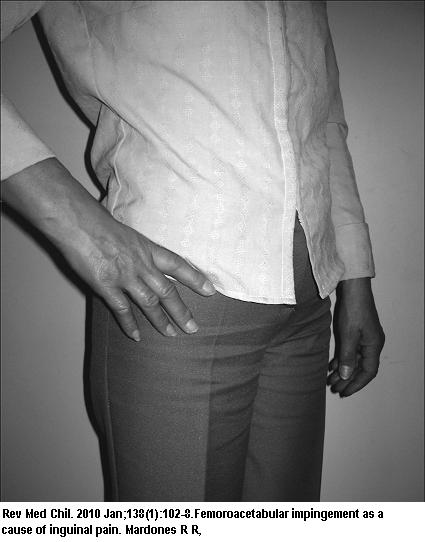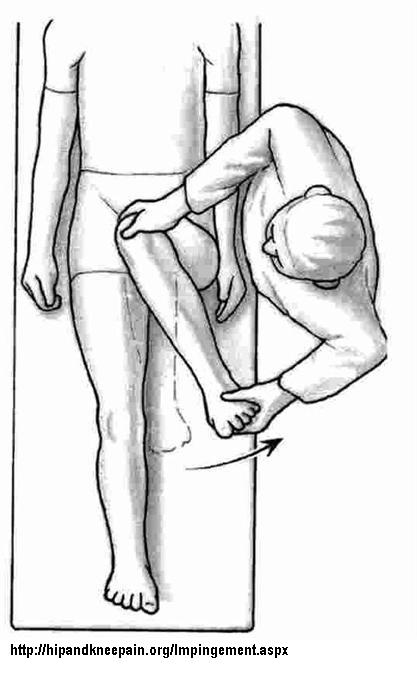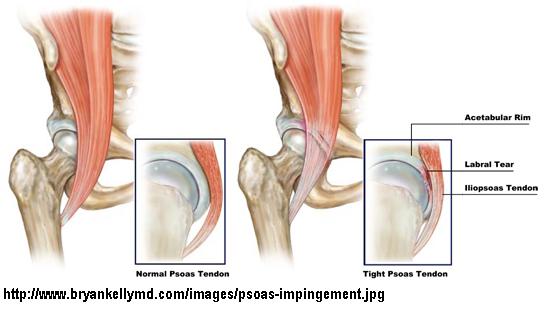Recent article found 10-15% of inguinal groin pain actually comes from an abnormality of the front of the hip joint. These people often are involved in multiple investigations when, injection of hip joint with local, proves the diagnosis.
Rev Med Chil. 2010 Jan;138(1):102-8. Epub 2010 Mar 26.
[Femoroacetabular impingement as a cause of inguinal pain.]
[Article in Spanish]
Mardones R R, Barrientos C V, Nemtala U F, Tomic A, Salineros U M abstract here
free full article here(hey you can always use google translate here)
Femoroacetabular (FA) impingement comes in two forms – where edge (Pincher) is too fat, and where head (Cam) is too fat. Either way, they pinch with certain movements.

- Fat cams are most common in young male athletes
- Fat pinchers are more common in active middle aged women
- Having both occurs in 86% of cases
- disease peaks in 20-40 yr olds and may be as prevalent as 10-15%
- presents with insidious groin pain often after trivial trauma
- Patient may describe the pain as spanning groin, trochanter and buttock areas – what the author calls the “C sign”

- worse with athletics or prolonged walking
- Hip impingement test – internal rotation and adduction with hip flexed 90 °

- I also check for impingement posterioinferiorly by – bringing butt over edge, dropping leg down and push some – (external rotate (opposite turn to pic) makes it worse – I’m surprized how often that will be an only positive finding on hip exam.
- deep hip joints are more at risk
- Close xray exam can suggest the problem.
- Often subjects are investigated and treated for multiple other issues – “laparoscopy, laparotomy, knee arthroscopy, lumbar spine decompression, and inguinal hernia repair.”
- left untreated promotes osteoarthritis progression
- surgery involves trimming down the area that’s too big – not a big procedure.
Comment – This syndrome was first made prominent by a publication in 2003:
Ganz R, Parvizi J, Beck M, Leunig M, Notzli H, Siebenrock KA.
Femoroacetabular impingement: a cause for osteoarthritis of the hip.
Clin Orthop Relat Res 2003; 417: 1-9.
- Initially, there were very few people in Canada trained to do procedures for this. Since then, many training courses have been offered and I think anyone that does hip arthroscopy will do it.
- Tight gluteal muscles make this worse – by pulling lower down, actually force the head more anterior- needling or injecting gluteal muscles can give good temporary relief
- Tight psoas can make it worse by pulling head forward.
- It has been suggested that during walking the through phase, gluteal muscles need to be activated to hold head properly – so tightening them then might help.
- An unstable hip obviously does not help.
Labral tears can occur anteriorly as well, and they can even pinch on the psoas muscle anteriorly, making it snap and confusing it with a plain snapping psoas – had a case like that…

Addendum
Eklem Hastalik Cerrahisi. 2011 Dec;22(3):129-33.
The relationship between chronic hip pain and femoroacetabular impingement: an evaluation with clinical signs and radiography.
Sahin N, Atıcı T, Oztürk A, Ozkaya G, Avcu B, Ozkan Y.
Found:
- Restricted hip internal rotation < 20 degrees in 18 (47.4%) patients in with FA syndrome versus one (2.4%) patient in controls (p<0.001).
- The painful passive internal rotation impingement sign was positive in 15 (39.5%) patients with FA syndrome and in one (2.4%) control patient (p<0.001)
addendum:
Ned Tijdschr Geneeskd. 2012;156(51):A4898.
Femoroacetabular impingement: frequently missed in patients with chronic groin pain.
Röling MA, Pilot P, Krekel PR, Bloem RM. abstract
- Reiterates that it is a cause of persistent groin pain often missed
- sharp pains with certain movements
- labral tear associated at impinmgment site can occur
Any comments?

Pingback: Can lower back pain be a symptom of a sports hernia?
Pingback: Enbrel Failure – So What Else Can You Do For Chronic Back Sciatica? | Pain Medical Musing